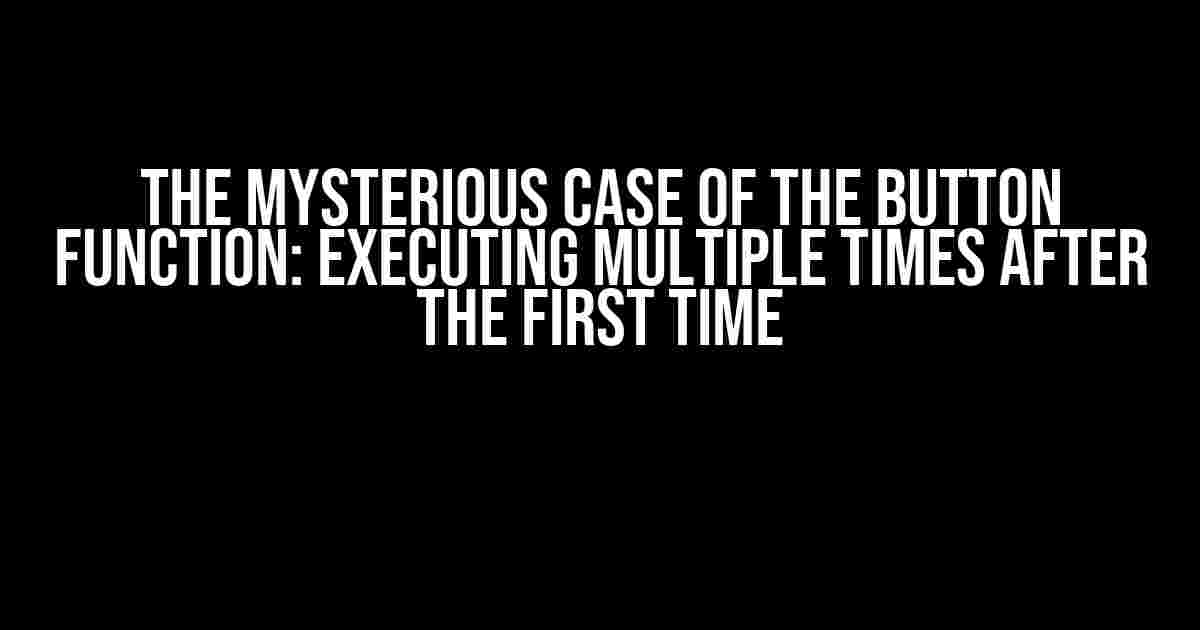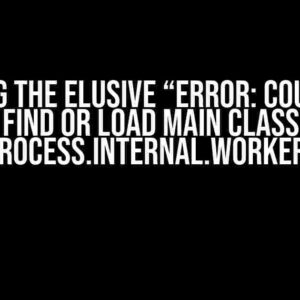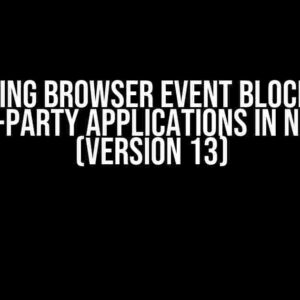Have you ever encountered a situation where your button function seems to be executing multiple times after the first time you click it? You’re not alone! This phenomenon has puzzled many a developer, leaving them scratching their heads and wondering what’s going on. In this article, we’ll delve into the possible reasons behind this behavior and provide clear, step-by-step instructions to help you troubleshoot and resolve the issue.
What’s Causing the Button Function to Execute Multiple Times?
Before we dive into the solutions, let’s explore the possible causes of this problem. Take a look at the following scenarios:
- Event Listener Issues: Perhaps you’ve attached multiple event listeners to the button, causing it to fire multiple times. This can happen when you add event listeners within a loop or when you forget to remove previous event listeners.
- Bubble and Capture Phases: Event listeners can capture and bubble events, leading to multiple executions. This occurs when you have nested elements with event listeners, and the event propagates through the DOM tree.
- Async Code and Callbacks: If you’re using asynchronous code or callbacks, it’s possible that the button function is executing multiple times due to the asynchronous nature of the code.
- Global Variables and Scope: If you’re using global variables or have issues with variable scope, it can lead to unexpected behavior, including the button function executing multiple times.
Debugging and Troubleshooting
Now that we’ve identified the possible causes, let’s get into the nitty-gritty of debugging and troubleshooting. Follow these steps to identify and fix the issue:
- Check the Event Listeners: Use the browser’s developer tools to inspect the button element and check the attached event listeners. You can do this by:
console.log(document.querySelector('button').listeners)This will show you a list of event listeners attached to the button. Look for any duplicates or unexpected listeners.
- Verify the Event Propagation: Use the `stopPropagation()` method to prevent event bubbling and capture:
document.querySelector('button').addEventListener('click', function(event) { event.stopPropagation(); // your code here });This will help you identify if the issue is related to event propagation.
- Review Async Code and Callbacks: Examine your asynchronous code and callbacks to ensure they’re not causing the issue. Consider using promises or async/await to simplify your code.
document.querySelector('button').addEventListener('click', async function() { try { // your async code here } catch (error) { console.error(error); } });This will help you identify if the issue is related to asynchronous code.
- Check Global Variables and Scope: Review your code for global variables and scope issues. Ensure that your variables are properly scoped and not conflicting with other parts of your code.
let button = document.querySelector('button'); button.addEventListener('click', function() { let localVariable = 'local scope'; console.log(localVariable); });This will help you identify if the issue is related to global variables or scope.
Common Solutions to the Problem
Now that you’ve identified the cause of the issue, let’s explore some common solutions to prevent the button function from executing multiple times:
| Solution | Description |
|---|---|
| Unbind Event Listeners: | |
| Use a Flag Variable: | Implement a flag variable to track the execution of the button function. Set the flag to `true` when the function is executed, and check its value before executing the function again: |
| Disable the Button: | Disable the button after the first click to prevent multiple executions: |
| Use a Debounce Function: | Implement a debounce function to limit the execution of the button function to a certain time interval: |
Conclusion
The mysterious case of the button function executing multiple times after the first time is a common issue that can be resolved with a combination of debugging, troubleshooting, and creative problem-solving. By identifying the root cause of the issue and implementing one or more of the solutions outlined above, you can prevent the button function from executing multiple times and ensure a smoother user experience.
Remember, debugging is an art that requires patience, persistence, and a willingness to learn. Don’t be afraid to experiment, try new approaches, and seek help when needed. With practice and experience, you’ll become a master debugger, ready to tackle even the most complex issues that come your way!
So, the next time your button function decides to go on a wild ride, remember to stay calm, grab your debugging tools, and follow the steps outlined in this article. With a little creativity and determination, you’ll be able to tame the beast and get your code back on track.
Here are 5 FAQs about “button function executes multiple times after the first time” in a creative tone:
Frequently Asked Question
Get the inside scoop on why your button function is going rogue!
Why does my button function execute multiple times after the first click?
This sneaky behavior is often caused by event listeners being added multiple times to the same button. It’s like having multiple party crashers showing up uninvited! Make sure to remove any existing event listeners before adding a new one to prevent the function from executing multiple times.
Is it possible that my button function is being triggered by another event?
You bet! Sometimes, a different event can trigger your button function, causing it to execute multiple times. For example, if you have a keypress event listener that triggers the button function, it might fire multiple times if the user holds down the key. Be sure to check if there are any other events that could be triggering your function.
Can I prevent the button function from executing multiple times by using a flag variable?
You’re absolutely on the right track! Using a flag variable can be a great way to prevent the button function from executing multiple times. Simply set the flag to true when the function is executed, and then check the flag before executing the function again. If the flag is true, don’t execute the function. It’s like putting up a “do not disturb” sign on your function’s door!
What if I’m using a JavaScript framework or library that’s causing the issue?
Ah-ha! Sometimes, the framework or library you’re using can cause the button function to execute multiple times. Check the documentation to see if there are any known issues or workarounds for this problem. You might need to use a specific method or configuration to prevent the function from firing multiple times. It’s like finding the secret ingredient in your favorite recipe!
How can I debug my code to find out why the button function is executing multiple times?
Debugging is like being a code detective! Use the console.log() function to log messages at different points in your code to see where the function is being executed. You can also use the debugger keyword to pause the code execution and inspect the call stack. It’s like following the bread crumbs to find the source of the issue!



